The Metaverse Economy Developed With NFTs – Part 3
Several metaverse projects are experimenting with the different ways to utilize NFTs in the metaverse. The goal of these projects is to determine how NFTs will fuel the digital economy.
Companies like JP Morgan, Meta, and Nike are just some of the big brands that are investing in the metaverse. A growing interest in digital assets and also financial instruments has emerged within the metaverse economy, and NFTs play a big role.
For example, fashion brands could open virtual stores to encourage customers to try digital items before purchasing the physical ones. Users can dress their avatars in the latest fashion attire before buying a physical piece of clothing. There is great potential to leverage NFTs in the metaverse, and brands are continuously experimenting with new business models. However, the general premise behind the use of NFTs in the metaverse is to buy the digital item (NFT) in the metaverse and have the physical item delivered to your door.
An advantage of using NFTs for virtual stores is that companies can potentially avoid the problem of overproduction by manufacturing products that people already want to buy.
Not only can we use NFTs for standalone assets, like a piece of art or a virtual house. They could also have uses in issuing loans or collecting royalties, both in fiat money and cryptocurrency.
From uses such as acting as a financial instrument to full business models, the enormous potential of this blockchain-based tech will have metaverse developers and investors excited for the future.
Scarcity will play a big role in how the economy of the metaverse develops.
Technically, with very little work, everything digital can be duplicated or multiplied. This can lead to hyperinflation and devaluation of assets. But, if scarcity can be maintained, the metaverse would become a new frontier for investment via the trading of unique and in-demand virtual assets. NFTs’ promising attributes will undoubtedly help make that vision possible.
Digital Real Estate In The Metaverse
The metaverse is currently going through a land rush, with investors pouring millions into virtual real estate. Purchases like virtual mansions for avatars to hang out in have become a trend.
But the land rush phase is only the first stage of a developing economy.
Plots of land don’t just get value from their use as an area to build a virtual house on. They often have promise as an investment or business asset.
Many plots of virtual land bought up by consumer brands, corporations, and investment funds will hope to flip them further down the line or rent them out.
Once interest in metaverse business becomes more commonplace, in turn, the land will naturally become more valuable to investors.
Virtual malls, luxury stores, concert or sports arenas, museums, and other virtual reality experiences are all potential businesses that organizations need virtual land for, including other types that don’t exist yet.
NFTs can carry ownership of virtual land, which can be bought, sold, rented, or developed.
Whether a plot of land in The Sandbox, a luxury apartment on the Solana blockchain, or a villa next to Snoop Dogg’s mansion, it can provide passive income to the owners via rent or even ad revenue. Building a shopping mall or concert venue, for example, would amplify potential returns greatly.
NFT-Based DeFi
The metaverse is the natural progression of web3. Most of its current economy operates on blockchain technology.
DeFi (decentralized finance) has become the foundation of processing transactions within the metaverse economy, as is the case with NFTs.
Total spending on NFTs was reportedly more than $12.6 billion as of the end of 2021. A vast amount of this money would have had to go through DeFi via exchange platforms.
You can collect rent, dividends, royalties, or other forms of passive revenue streams from the use of NFTs.
For example, at the end of 2020, MetaKovan won an auction for a segment of a digital Monaco racing track in the F1 Delta Time game. This allowed him to collect 5% dividends from all of the races and also special events that took place in the game.
You could design an NFT to generate virtual currency yields to their holders. CyberKongz ($BANANA) and Mutant Cats ($FISH) have both made use of this function.
NFTs can be staked, nested, or used as loan collateral.
To stake a token, the owner usually has to lock it away for a certain period of time in a DeFi protocol smart contract for the purpose of generating yield.
Nesting means adding new NFTs or smart contracts to an already minted NFT, which can boost its value.
Let’s take a closer look at how buyers can earn residual income (passive yields) and maximize the potential of their investments:-
Yield-generating NFTs
The issue of timing markets in Web3 will often have even the most seasoned investors struggling to make the right trades. So, to create a more practical incentive and to mitigate against the volatility of the sector, various projects give the option of generating passive returns, some of whom issue governance tokens to NFT holders.
Mutant Cats offer this service, and also Genesis Cyber Kongz, with the latter set to produce 10 $BANANA tokens every day for the next ten years.
Other projects that offer yield protocols such as these include SupDucks ($VOLT) and Bored Ape Yacht Club ($APE), who launched their own token on 16 March 2022.
Staking NFTs
As well as collecting NFTs for generating passive yields, investors can benefit from NFTs through DeFi protocols by staking (locking up their assets) in a smart contract to receive rewards.
Because of strict regulations around security, most rewards come in the form of tokens specific to a project. Their use can include features like governance or voting rights. Decentralized exchanges like PancakeSwap, SushiSwap, or Uniswap allow stakers to sell some of these tokens in the market.
Nested NFTs
In the past, NFTs were always quite static; generally, what was minted or bought in a secondary market couldn’t be changed. Platforms like Charged Particles, however, make it possible to layer NFTs onto other NFTs.
By transforming one NFT into a “virtual basket”, you can hold multiple ERC-based tokens as a nested NFT. This new type of nested NFT can add intrinsic value to collectibles and turn a speculative investment into a yield-generating asset.
Nested NFTs provide value for users in the metaverse through customization and the addition of new functionality for virtual items.
NFTs In GameFi
NFT technology makes for a powerful base for game economies, whether used as an element of P2E gaming (Play-to-earn), trading items like rare drops or self-made accessories, selling avatar skins, collecting royalties for designing levels, buildings, or businesses based in games.
NFTs can also warrant property rights for equipment and user-generated content, among other things.
The tokens can be an investment, a way of building a business, or a means of earning passive income from gaming.
An example of this is the scholarship model in Axie Infinity. Players have to buy a starter team of “Axies” before they can play the game.
Some players can’t afford or don’t want to pay money to play a game. They can, instead, enlist to work for another team owner. The players can then earn a share of the rewards they win in a game.
For further reading on the GameFi and metaverse economy sector, check out our other blog posts…


